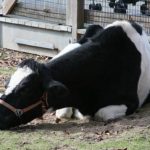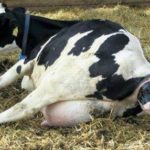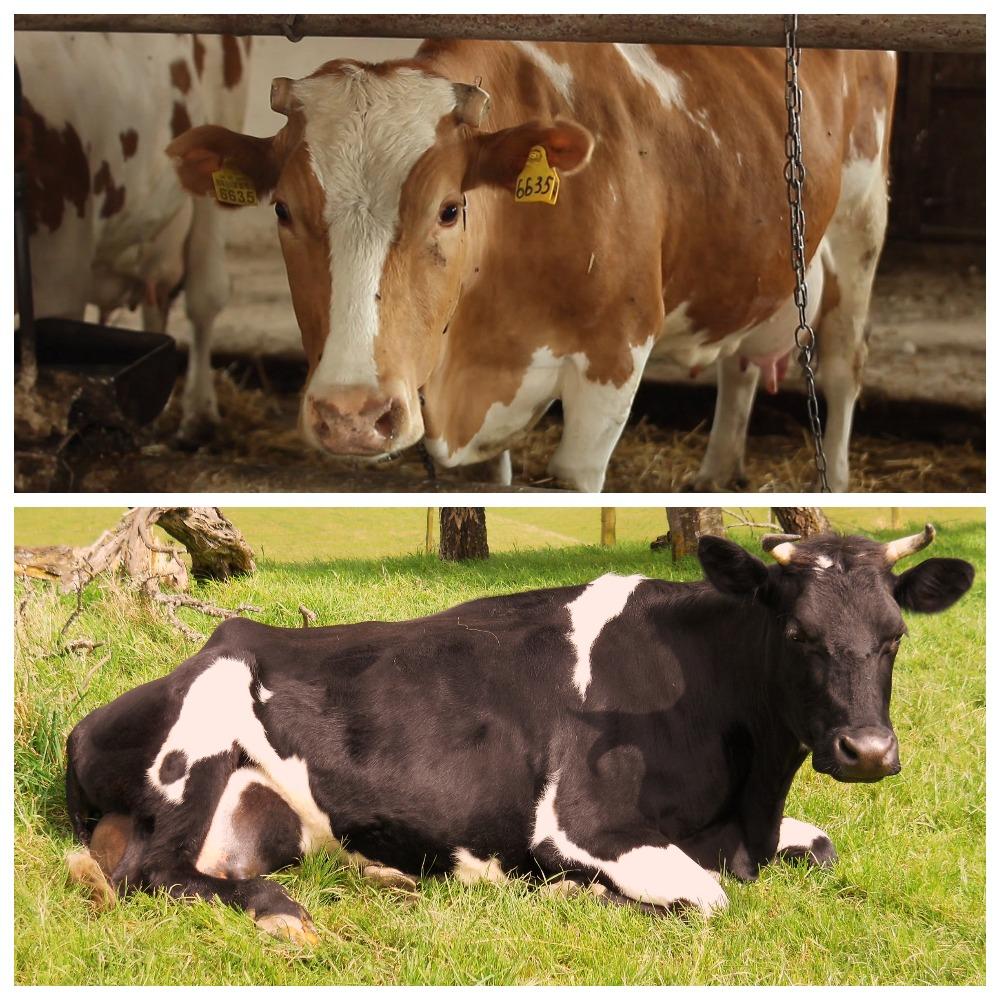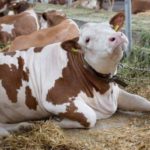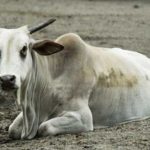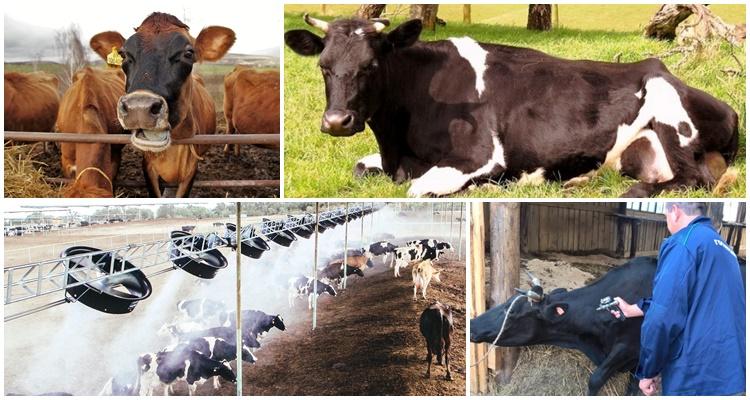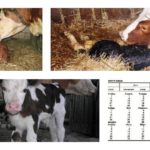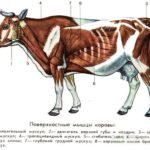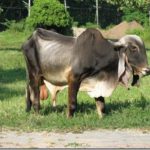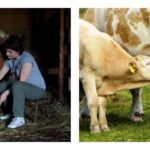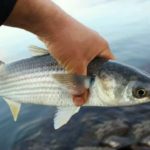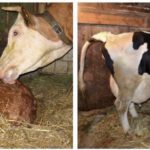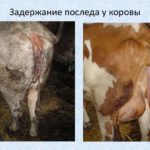Cows spend most of their lives on pastures for walking. In a normal healthy state, individuals walk, lie down and stand up freely. During various pathological processes, cows fall on their feet. The danger of the situation is that when lying down for a long time, a number of internal changes occur: the functioning of the liver, kidneys, and lungs is disrupted. If the animal is not raised, there is a risk of death. What to do if the cow does not get to her feet and is weakened?
Main reasons
Cattle anatomy It is designed in such a way that when rising, the individual first straightens its hind limbs and then its forelimbs. If the animal cannot lift the back of its body, it remains lying down. Paralysis in cows most often develops after birth due to compression of the gluteal nerve or nerve endings of the sacral region.
Postpartum paresis is also explained by the unbalanced diet of the cow during pregnancy (sharp loss of calcium after childbirth). Other reasons are a narrow pelvic region or its irregular structure. It's not just cows that give birth that fall to their feet. The problem affects both young animals, bulls, and old individuals. A number of factors lead to this:
- Injuries, dislocations, sprains. The animal should be carefully inspected for damage. This may include swelling, swelling, redness, or unnatural position of the limb.
- Arthritis of the joints. The cow does not get up due to acute pain. Signs of pathology are a joint that is hot to the touch, swelling, and a change in the shape of the joint. An increase in overall temperature is possible.
- Hoof problems - stuck stone, inflammation or infection.
- A sharp transfer of young animals from a dairy diet to roughage. The stomach becomes clogged with grain and earth. This causes severe pain and a desire to lie down constantly.
Other, less common reasons for a cow to fall and become weak include micronutrient deficiency. In winter, individuals lie down due to insufficient activity. A similar problem is typical for crowded housing in stalls: animals simply have nowhere to roam. Congenital defects in the structure of joints also cause falling on feet.
White muscle disease
This is muscular dystrophy, at risk are young animals from the first days to 3 months of life. It develops due to the lack of selenium and vitamin E in the body.The disease is characterized by disruption of metabolic processes and the inability to contract muscles. The danger of the pathology is that it is incurable. Recovered individuals develop slowly and are most often discarded and sent for slaughter. The young animals waste away slowly; owners often do not see obvious signs of illness in the individuals. The problem is usually noticed only when the calf falls to its feet. There is no point in raising an animal anymore. The only solution is slaughter.
Phosphorus deficiency
Phosphorus deficiency entails serious metabolic changes in the animal's body. This leads to a slowdown or complete cessation of growth. Bone mineralization is impaired, joints increase in size.
Ketosis
The second name is acetonemia, or protein poisoning. The disease is caused by an excess of ketones in the body.
Ketone bodies appear due to excessive consumption of protein feeds:
- Ammonia absorption slows down.
- Acids are formed on its basis.
- The acids are converted into acetone and beto-hydroxybutyric substance, which pollute the body.
Mild symptoms include intoxication and perversion of appetite. In severe form, oppression begins, and it becomes difficult for the cow to stand. There is no reliable support when rising from a lying position. The animals' legs haven't given up, they just have a hard time leaning on them.
Rickets
These are anomalies in the structure of bones that appear in growing young animals. The disease is accompanied by degenerative processes in bone tissue: ossification, proliferation, softening, atrophy. The reason is a lack of exercise and vitamin D.
A cow falling on its feet during rickets is a common occurrence, since crooked and thin limbs cannot support even a small weight.
Osteomalacia
A dangerous chronic disease in which the bones soften. This is rickets for adults. Highly productive, pregnant and lactating cows are especially susceptible to pathology. The reason is a lack of minerals (calcium, vitamins, phosphorus), insufficient walking.
Osteomalacia occurs in 3 stages:
- Appetite disappears, taste preferences are distorted, digestion is upset.
- Problems with mobility appear: any movement causes pain, joints click, and vertebrae dissolve.
- Bones become flexible and soft, noticeably curved, and the risk of fractures and paralysis is high. The cow is exhausted and lies down.
The disease develops slowly, becoming chronic over the years. Osteomalacia has no cure. Progression can only be slowed down. Therefore, it makes no sense to raise old individuals to their feet. If a cow is over 8 years old and has been diagnosed with this disease, it is better to sell it for meat.
How to help a cow get back on her feet
The cow should stand on its own after intravenous injections. If falling on your feet is caused by metabolic problems, some farmers use the hanging method. This is a controversial, subjective and temporary technology: a panel is secured between the front and hind legs of the cow, and the animal is lifted with a winch. This suspension can be used for no more than 2 days. If the individual does not begin to stand on its own, it will have to be killed. To raise a cow to her feet after calving, the following technology is used:
- Remove the newborn calf.
- Methods - a sharp sound (if the cause of the fall was postpartum shock), suffocation for 10-15 seconds.
- When the cow begins to stand up, it is important to support her from the tail and head.
Drug therapy
The therapeutic regimen depends on the cause of the pathological phenomenon. In any case, the cow must be isolated from the herd during treatment. It is important to provide constant access to clean water, provide balanced feed, and add calcium salts and phosphorus. Use vitamin complexes, fish oil, glucose. Be sure to regularly consult with a veterinarian regarding the animal's condition.
| Cause/disease | Treatment tactics |
| White muscle disease | The basis is the use of selenium preparations. “E-selenium”, “Hydropeptone” are used. To maintain cardiac function, glycosides are given (caffeine, Sulphocamphocaine). |
| Phosphorus deficiency | Medicines – “Urzolit”, calcium hypophosphite, vitamin D injections. Oral intake of calcium phosphate, disodium phosphate. |
| Ketosis | Solutions with high glucose content. Injections every 12 hours. |
| Rickets | Drugs for treatment - “Tetravit”, “Trivit”, “Trivitamin”. |
| Osteomalacia | Calcium borogluconate. Administered subcutaneously or intravenously. A total of 2 repetitions are required. |
| Postpartum paresis | Subcutaneous injections of caffeine with magnesium sulfate solution. Intravenous injections of calcium chloride and glucose. |
Veterinarian advice
Experts advise carefully monitoring the condition of the animal and periodically inspecting it. Check the condition of the joints and hooves once every 4-6 months. To prevent unpleasant complications, calves should be gradually and carefully transferred from milk to feed, alternate and dilute the diet. It is imperative to give cows vitamin supplements to prevent immune decline.
If a cow falls on its feet, but there is still hope of curing the animal, you need to massage it daily. Rub the limbs and sacrum to normalize blood circulation. A lying cow should be turned over 2 times a day to prevent the formation of bedsores. You should also rub your body with a straw tourniquet every day to prevent tissue necrosis.
If the cow weakens and falls on her feet, this indicates serious health problems. There are several reasons for this phenomenon: from inflammation of the hooves and joints to a lack of minerals and a number of diseases. Females most often fall on their feet after calving. The problem requires an urgent solution: lifting, rubbing and massage, drug intervention. If a cow does not get up for a long time, it is sent to slaughter.


